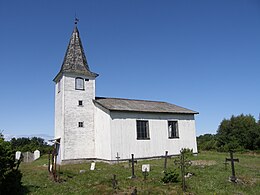Prangli
 Prangli church | |
 | |
| Geography | |
|---|---|
| Location | Baltic Sea |
| Coordinates | 59°37′28″N 25°01′15″E / 59.62444°N 25.02083°E |
| Area | 6.44 km2 (2.49 sq mi) |
| Highest elevation | 9 m (30 ft) |
| Administration | |
Estonia | |
| County | Harju |
| Demographics | |
| Population | 151 |
| Pop. density | 23/km2 (60/sq mi) |
Prangli (Swedish: Vrangö) is an Estonian island in the Gulf of Finland.
The earliest known written records of Prangli date from 1387, the island was then called Rango and it had been settled by Swedes. The first Estonian-speaking inhabitants are known to have lived on the island in the 17th century.
Prangli is part of Viimsi Parish. In Kelnase is a harbour which is connected by ferry to Leppneeme on the mainland.
The vegetation, especially in the east of the island, is mainly fir trees.
The lighthouse on Prangli was built in 1923.
In 1941, the Estonian steamship Eestirand was shipwrecked off the coast of Prangli Island after a German air attack. The Eestirand was part of a fleet of ships carrying Soviet troops to Leningrad during the Soviet evacuation of Tallinn.[1] The Estonian crew and conscripts managed to disarm Soviet military personnel aboard the ship and take control of the island, hoisting the flag of the Estonian Republic up a tall pine tree.[2] The revolt saved approximately 2,700 conscripts, most of which were Estonian, from being mobilized to Leningrad. After the war, a memorial was placed on the island in honor of those who died in the tragedy.
Gallery
[edit]-
House of culture
-
Local store
-
Mälgi harbour
-
Kelnase harbour
-
Prangli NW light beacon
-
Museum
-
Boat Helge
-
Glacial erratic
-
Eestirand Memorial site
-
Buildings in Prangli
-
Hut
-
Coast
References
[edit]- ^ Taylor, Neil (2014). Bradt Travel Guide: Estonia. Bradt Travel Guides. p. 128. ISBN 9781841624877. Retrieved 9 December 2014.
- ^ Rikken, Kristopher (24 August 2011). "1941 Steamer Tragedy, Revolt Remembered". Estonian Public Broadcasting. Retrieved 10 December 2014.
External links
[edit]












